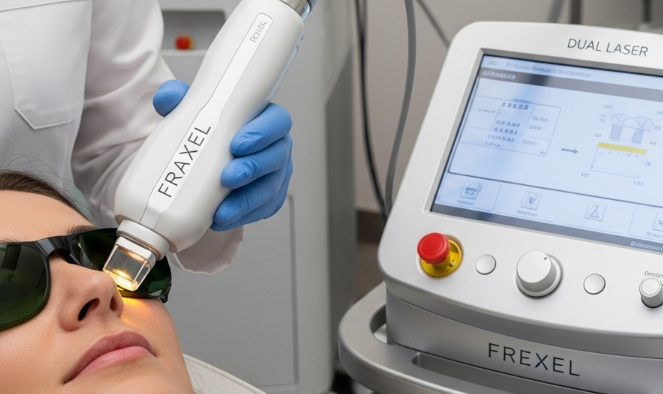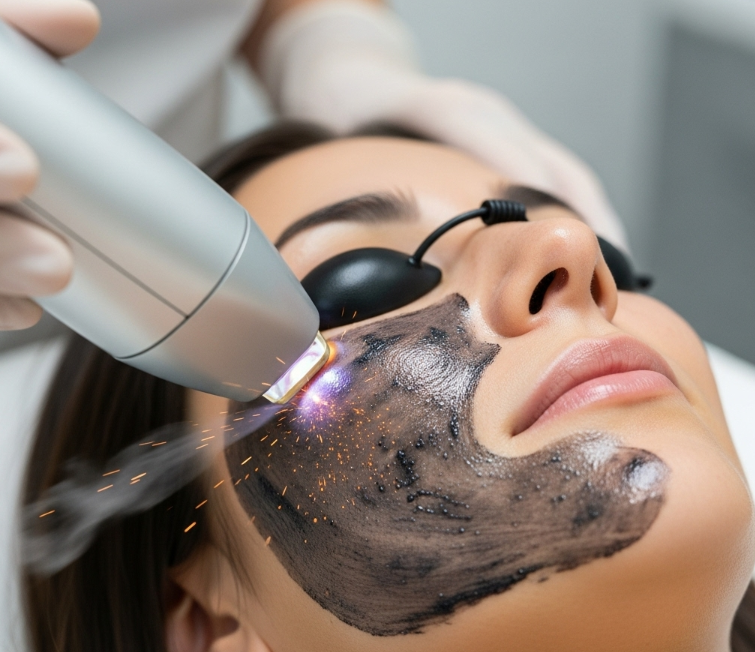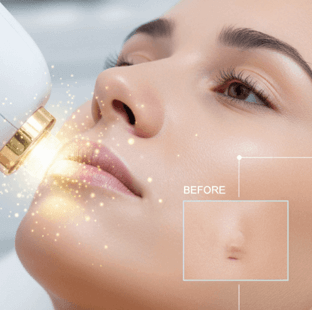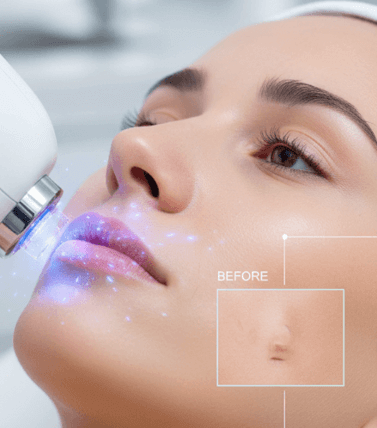Treatment Overview
The Fraxel Dual Laser is a fractional, non-ablative laser system that combines two wavelengths: 1550 nm (deep dermal remodeling) and 1927 nm (superficial pigment correction). By creating microscopic treatment zones, it stimulates collagen regeneration, accelerates cell turnover, and breaks down pigmentation.
In Korea, Fraxel Dual is used as part of comprehensive melasma management, particularly in cases of epidermal melasma, mixed-type melasma, or melasma associated with textural irregularities and sun damage. Since melasma is a chronic and recurrent condition, Fraxel is generally applied with conservative settings or in combination with toning lasers to reduce the risk of PIH (post-inflammatory hyperpigmentation).
It belongs to the Pigmentation Treatment family (Fraxel Dual, Nd:YAG Toning, Dual Toning, Gold Toning, Pico Lasers, CO₂ Fractional, Clear + Brilliant):
- Fraxel Dual: Best for melasma + sun damage + texture.
- Nd:YAG Laser Toning: Best for dermal melasma.
- Dual Toning: Best for multi-layer melasma.
- Gold Toning: Best for vascular melasma.
- Pico Lasers: Best for resistant melasma + scarring.
- CO₂ Fractional: Best for melasma with texture/scars (higher risk).
- Clear + Brilliant: Best for mild melasma + maintenance.
Purpose & Benefits
- Melasma Reduction: Lightens superficial and mixed melasma patches.
- Sun Damage Correction: Fades sunspots, age spots, and pigmentation from UV exposure.
- Texture Refinement: Smooths fine lines, acne scars, and roughness.
- Collagen Remodeling: Improves elasticity and firmness.
- Preventive Care: Slows recurrence of pigmentation when combined with toning lasers.
- Minimal Downtime: Non-ablative, so healing is quicker compared to ablative CO₂.
Ideal Candidates
Fraxel Dual in Korea is recommended for:
- Adults with epidermal or mixed-type melasma.
- Patients with melasma plus textural issues (scars, enlarged pores, fine lines).
- Individuals with UV-related pigmentation and sun damage.
- Men and women comparing treatments:
- Fraxel Dual: Best for melasma + texture + sun damage.
- Nd:YAG: Best for deeper dermal melasma.
- Dual Toning: Best for multi-layer melasma.
- Gold Toning: Best for vascular melasma.
- Pico Lasers: Best for resistant melasma + PIH.
- CO₂ Fractional: Best for melasma + scarring, but higher PIH risk.
- Clear + Brilliant: Best for mild or preventive care.
Possible Risks & Complications
Fraxel Dual is safer than ablative resurfacing, but melasma patients require caution. Possible side effects include:
- Redness & Swelling: Common, lasting 2–3 days.
- Bronzing Effect: Skin may darken before peeling.
- Flaking/Peeling: Normal part of skin renewal.
- Risk of PIH: Especially in aggressive settings or darker skin (minimized in Korea with conservative protocols).
Surgical Techniques Used
Fraxel Dual uses fractional photothermolysis with dual wavelengths:
- 1550 nm: Penetrates dermis for collagen stimulation and scar repair.
- 1927 nm: Targets epidermis for superficial melasma and pigmentation.
- Fractional Mode: Creates microthermal zones with surrounding healthy tissue for faster recovery.
- Protocol: 3–5 sessions spaced 4–6 weeks apart; melasma patients treated with low-to-moderate settings.
Recovery & Aftercare
- Immediately: Redness, mild swelling, and warmth.
- 2–3 Days: Skin darkens slightly, feels rough (“sandpaper” texture).
- 5–7 Days: Flaking, peeling, and pigment shedding.
- 1–2 Weeks: Brighter tone and clearer texture.
Aftercare Tips:
- Use SPF 50+ daily to prevent rebound melasma.
- Apply soothing and hydrating creams.
- Avoid exfoliants, retinoids, or acids for 7–10 days.
- Limit sun and heat exposure during recovery.
Results & Longevity
- After First Session: Fresher tone and improved texture.
- Short-Term (2–3 Sessions): Visible lightening of melasma patches and sunspots.
- Medium-Term (3–5 Sessions): Improved tone, texture, and reduced recurrence risk.
- Long-Term: Results last 6–12 months with maintenance (often paired with toning lasers).
Treatment Process in Korea
- Consultation & Skin Analysis – Doctor determines melasma type and evaluates texture/sun damage.
- Preparation – Cleansing, numbing cream, and protective eyewear.
- Fraxel Dual Session – 1550 nm and/or 1927 nm applied in fractional passes.
- Post-Care: Cooling mask, hydration serums, or antioxidant infusion.
- Follow-Up: Multi-session plan, often combined with toning or Pico lasers for melasma.
Why Korea is a Top Destination
- Korea’s dermatologists are experts at customizing Fraxel protocols for Asian skin.
- Clinics use low-fluence, safe settings for melasma to avoid rebound.
- Affordable compared to Western Fraxel treatments.
- Korean protocols often combine Fraxel + Nd:YAG or Pico Lasers + skin boosters (Rejuran, exosomes) for synergy.
- Seoul is internationally recognized for skin rejuvenation and pigmentation control programs.
Cost Range (Detailed Breakdown)
Pricing for Fraxel Dual in Korea:
- Single Session (full face): USD 300 – 600
- 3–5 Session Package: USD 1,200 – 2,500
- Premium Package (Fraxel + Toning/Pico + Boosters): USD 1,800 – 3,500
Additional Costs in Korea:
- Consultation: USD 20 – 50
- Add-ons (Rejuran, PN boosters, exosomes, whitening drips): USD 100 – 500
💡 The Fraxel Dual is often called “the melasma + sun damage corrector” in Korea, since it not only helps lighten pigmentation but also improves texture, scars, and overall skin quality.
Popular Clinics
- Banobagi Dermatology (Seoul): Fraxel Dual for melasma + sun damage.
- Oracle Dermatology (Seoul): Combination Fraxel + Nd:YAG for mixed melasma.
- Renewme Skin Clinic (Seoul): Fraxel Dual + boosters for pigment and texture.
- View Plastic & Dermatology (Seoul): Fraxel Dual with Pico toning for stubborn melasma.
- Chaum Anti-Aging Center (Seoul): Premium Fraxel Dual melasma programs with regenerative add-ons.




